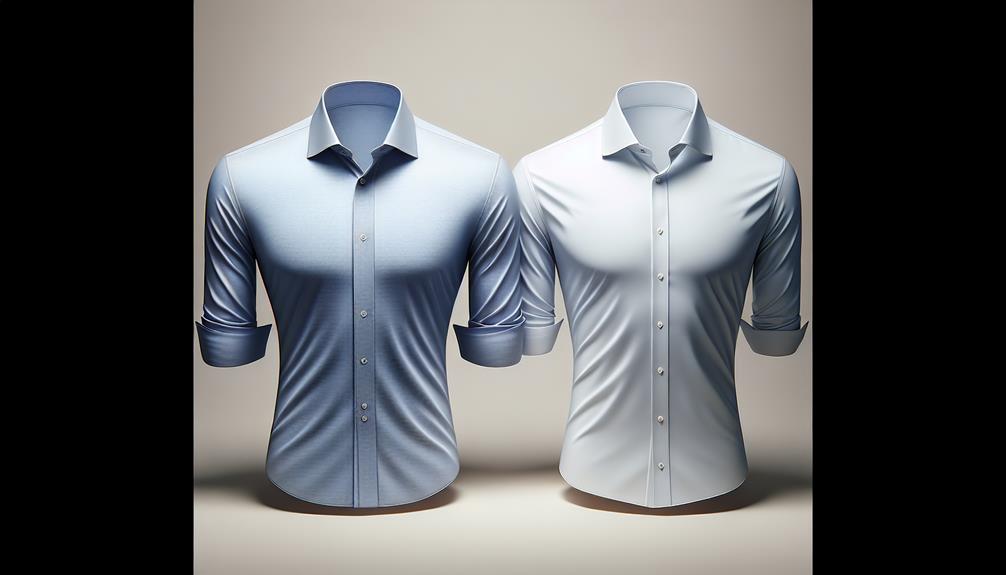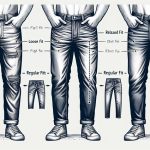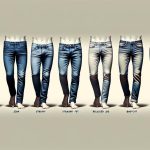Regular fit and slim fit clothing can greatly impact how an outfit looks on you. When deciding between the two, it's important to understand the nuances that set them apart.
From the way they are tailored to how they complement different body shapes, each fit offers distinct advantages. But which one is the right choice for you? Let's unravel the differences together and find out which style suits you best.
Table of Contents
Key Takeaways
- Regular fit offers a looser, relaxed cut with more room, while slim fit provides a tailored, sleek silhouette.
- Slim fit suits leaner builds with narrower openings, while regular fit accommodates broader shoulders and waists.
- Tailoring techniques can adjust fits for different body types, with stretch fabrics in slim fit offering flexibility.
- Styling options vary between regular and slim fit, with tailored appearances and versatile looks for each fit.
Regular Fit Vs. Slim Fit: Overview
When choosing between regular fit and slim fit clothing, understanding the key differences in how they're designed to fit can make a significant difference in your overall comfort and style. Fabric choices play a critical role in the distinction between these two fits. Regular fit garments typically use more fabric and have a looser cut, offering a relaxed feel and greater ease of movement. On the other hand, slim fit clothing is tailored closer to the body, using less fabric and creating a sleek, modern silhouette.
In regard to styling, fit preferences and trends also influence the decision between regular and slim fit. Those who prefer a classic and timeless look often opt for regular fit attire, which provides a traditional appearance. Conversely, slim fit clothing is favored by individuals seeking a more contemporary and streamlined aesthetic. Understanding these aspects can help you choose the fit that aligns best with your personal style and comfort preferences.
Understanding Sizing Differences
Moving from the distinction between regular fit and slim fit, let's now explore the differences in sizing between these two clothing styles. When it comes to sizing variations and fit preferences, understanding measurements and style choices becomes important.
- Regular Fit Sizing: Regular fit clothing tends to have a more generous cut, providing a comfortable and relaxed feel. The measurements for regular fit garments are more forgiving, allowing for a broader range of body shapes.
- Slim Fit Sizing: Slim fit clothing is designed to offer a more tailored and snug appearance. The measurements for slim fit items are narrower, catering to individuals who prefer a closer-fitting silhouette.
- Length Differences: Slim fit garments often have shorter lengths compared to regular fit counterparts to create a sleeker look.
- Arm and Leg Openings: Slim fit styles typically feature narrower arm and leg openings, while regular fit options offer more room in these areas for increased mobility and comfort.
Key Features of Regular Fit
Regular fit clothing provides a more relaxed and comfortable fit compared to its slim fit counterpart, catering to a broader range of body shapes. When it comes to the key features of regular fit garments, they're known for their traditional style and classic look. Regular fit clothing tends to have more room in the chest, waist, and sleeves, offering a comfortable feel without being too loose or too tight. The silhouette of regular fit attire is straight from the shoulders to the hem, providing a balanced and timeless appearance.
One of the advantages of regular fit clothing is its versatility. Whether you're dressing up for a formal occasion or going for a casual look, regular fit clothing can easily adapt to different styles. Additionally, regular fit apparel allows for ease of movement, making it a practical choice for everyday wear. The overall aesthetic of regular fit garments is considered more conservative and accommodating, making them a popular choice for those who prefer a more relaxed and classic silhouette.
Key Features of Slim Fit
Slim fit clothing offers a more tailored and body-hugging silhouette compared to regular fit, emphasizing a sleek and modern look. When considering the key features of slim fit garments, there are several factors to keep in mind:
- Fabric selection: Slim fit clothing often uses stretch fabrics like elastane to allow for a more snug fit while still providing mobility and comfort.
- Tailoring techniques: Slim fit garments are typically constructed with closer seams and darts to contour the body, creating a streamlined appearance.
- Fit adjustments: Ensuring that slim fit clothing fits well without being too tight. Tailoring adjustments can be made to sleeves, waist, and pant length for a personalized fit.
- Styling tips: When wearing slim fit clothing, consider pairing it with slim-cut trousers or jeans to maintain a balanced silhouette. Layering with structured jackets can also enhance the tailored look.
Understanding these key features will help you make informed choices when selecting and styling slim fit clothing for a polished and modern appearance.
Suitability for Different Body Types
When choosing between regular fit and slim fit clothing, it's important to take into account your body shape. Tailoring garments to fit your physique can make a significant difference in how they look on you.
Your personal style preferences will also play a role in determining which fit is best suited for you.
Body Shape Considerations
Considering different body types is essential when choosing between regular fit and slim fit clothing styles to guarantee the best fit and comfort. When selecting the right fit based on body shape, here are some key points to keep in mind:
- Body Measurements: Regular fit may suit individuals with broader shoulders and a wider waist, while slim fit is better for those with a leaner build.
- Fabric Choices: Stretch fabrics in slim fit styles can provide more flexibility for movement and comfort.
- Height: Taller individuals may find that slim fit elongates their silhouette, while regular fit offers a more balanced look.
- Muscle Mass: Slim fit can accentuate muscle definition, whereas regular fit provides a more relaxed feel for those with a more muscular build.
Tailoring for Physique
To ensure the best fit for different body types, tailoring clothing styles to physique is key for ultimate comfort and style. Tailoring techniques play a vital role in ensuring that garments complement various body shapes. By customizing the fit through alterations, such as tapering the waist or adjusting sleeve lengths, individuals can achieve a more tailored look.
Fabric choices also impact how well a garment drapes on the body. Opting for stretch fabrics can provide a more forgiving fit for those with athletic builds, while structured fabrics can create a sleek silhouette for individuals with a slim frame. Understanding fit customization and alteration options allows for personalized clothing that enhances one's natural physique.
Style Preferences Impact
Style preferences greatly impact how well different body types can carry off a particular fit, influencing the overall look and comfort of the garment. When considering fashion trends and personal preferences, opting for a fit that complements your body type is crucial for a stylish and comfortable appearance.
Here's a breakdown of how style preferences can impact different body types:
- Fashion Trends: Following current fashion trends can lead to choosing a fit that may not be the most flattering for your body type.
- Personal Preferences: Your personal style choices play a significant role in selecting a fit that makes you feel confident and comfortable.
- Body Shape: Different fits can accentuate or disguise various body shapes, affecting how the garment looks on you.
- Comfort Level: Finding a fit that aligns with your style preferences and body type guarantees maximum comfort throughout the day.
Comfort and Mobility Comparison
Wearing a slim fit shirt allows for increased flexibility and comfort compared to a regular fit option. When it comes to comfort vs. style, the slim fit strikes a balance by offering a snug fit without compromising on mobility. The tailored design of a slim fit shirt contours to the body, providing a comfortable feel that moves with you throughout the day. In contrast, regular fit shirts tend to be looser, which can sometimes result in excess fabric bunching up and hindering your movements.
The flexibility vs. structure debate is also important. Slim fit shirts provide the flexibility needed for various activities, whether you're reaching for something on a high shelf or simply going about your daily tasks. On the other hand, regular fit shirts offer more structure but may limit your range of motion. Ultimately, the choice between slim fit and regular fit comes down to personal preference and how you prioritize comfort and mobility in your everyday wear.
Styling Options for Regular Fit
Let's talk about how to rock a Regular Fit style!
From classic color combinations to mastering layering techniques, there are numerous ways to elevate your look with a regular fit silhouette.
Whether you're dressing up for a casual outing or aiming for a smart-casual vibe, understanding these styling options can help you feel confident and stylish in your regular fit attire.
Color Combinations
Exploring various color combinations can enhance the versatility and appeal of outfits styled with regular fit clothing. When choosing colors for your regular fit pieces, consider the following:
- Contrast: Pairing dark bottoms with lighter tops creates a visually appealing contrast.
- Monochromatic: Opting for shades of the same color can create a sleek and sophisticated look.
- Complementary Colors: Combining colors opposite each other on the color wheel can add vibrancy.
- Neutral Base: Starting with a neutral base like black, white, or gray allows for easy incorporation of bolder colors in accessories.
Layering Techniques
Layering regular fit clothing allows for versatility in styling options and can elevate your overall look effortlessly. When choosing fabrics for layering, consider the weather to guarantee both comfort and style.
Lighter fabrics like cotton are great for layering in warmer climates, while wool or fleece work well for colder weather. The regular fit provides more room for layering pieces without looking bulky.
Experiment with different combinations such as a button-up shirt under a sweater or a denim jacket over a t-shirt. Accessories like scarves, hats, or belts can add a personal touch to your layered outfit.
Styling Options for Slim Fit
When styling slim fit clothing, consider opting for accessories that complement the fitted silhouette and enhance your overall look. Here are some styling options to make the most of your slim fit pieces:
- Layering tips: Layer a slim fit dress shirt under a well-fitted blazer for a sharp and sophisticated look. This adds depth to your outfit while maintaining the tailored appearance of the slim fit.
- Trendy accessories: Pair your slim fit jeans with a stylish leather belt and a classic watch to add a touch of elegance to your ensemble. Accessories like these can elevate a simple outfit to a more polished and fashionable level.
- Footwear choices: Opt for sleek shoes like loafers or oxfords when wearing slim fit trousers. These shoe styles complement the streamlined look of slim fit pants and complete the overall aesthetic.
- Minimalist jewelry: To keep the focus on your well-fitted clothes, choose minimalist jewelry pieces like a simple chain necklace or a sleek bracelet. These subtle additions can enhance your outfit without overwhelming the slim fit silhouette.
Final Thoughts and Recommendations
Let's wrap up our discussion by sharing some final thoughts and recommendations on styling options for slim fit clothing. When it comes to styling slim fit pieces, the key is to make sure that the clothing hugs your body without being too tight, allowing for both comfort and a sleek look.
Regarding fashion trends, slim fit clothing continues to be a popular choice for those seeking a modern and tailored appearance. Pairing slim fit pants with a well-fitted shirt and a blazer can create a sophisticated ensemble suitable for various occasions, from casual outings to more formal events.
For a casual yet stylish look, consider combining slim fit jeans with a simple t-shirt and sneakers. This effortless outfit can be elevated by adding a statement jacket or accessorizing with a stylish watch or belt.
Frequently Asked Questions
Can Regular Fit Clothing Be Altered to Achieve a Slimmer Fit?
Yes, regular fit clothing can be altered to achieve a slimmer fit. Tailoring options offer adjustments that can transform the fit. This customization caters to styling preferences and follows current trends, ensuring a more tailored and flattering look.
Are There Any Specific Fabrics That Are More Commonly Used in Regular Fit Versus Slim Fit Clothing?
In regular fit clothing, common fabrics include cotton blends for comfort and ease. Slim fit garments often use stretchier materials like spandex for a snug fit. Construction varies to accommodate styling choices and sizing restrictions.
How Do Regular Fit and Slim Fit Garments Differ in Terms of Durability and Longevity?
In comparing durability, regular fit garments often last longer due to their looser construction. Slim fit clothes may need more frequent alterations for a snug fit, affecting longevity. Fabric choices also play a role in lifespan.
Are There Any Differences in the Range of Motion and Flexibility Between Regular Fit and Slim Fit Clothing?
When it comes to range of motion and flexibility, slim fit clothing tends to offer a more tailored and snug fit, which can limit movement compared to regular fit garments. However, the trade-off often comes with added style and a modern look.
Do Regular Fit and Slim Fit Clothing Require Different Care Instructions for Washing and Maintenance?
When caring for regular fit versus slim fit clothes, I pay attention to washing instructions. Regular fit garments might shrink less than slim fit ones. Alterations might be needed for slim fit items more frequently to maintain the desired look.
- Why Is Red Velvet Not Red? - April 25, 2024
- How Do You Describe Velvet Fabric? - April 25, 2024
- How Strong Is Velvet? - April 25, 2024








